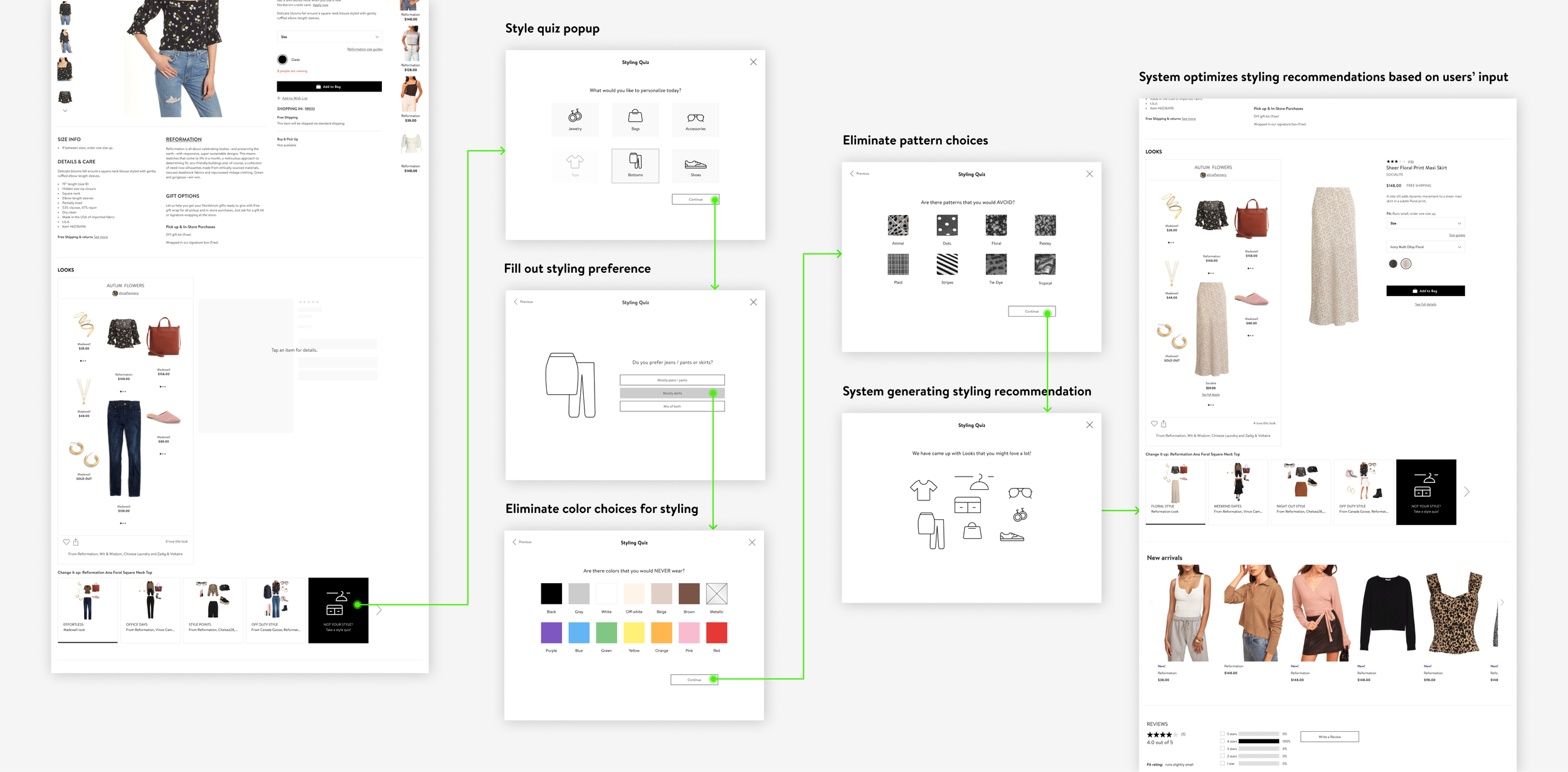Nordstrom Looks
Optimizing “Looks” feature –––– designing outfits styling for Nordstrom’s online shoppers
Overview
Background
Nordstrom Looks is a product feature on Nordstrom's website and mobile app that gives outfit styling recommendations for Nordstrom's online shoppers. Nordstrom sponsored us to conduct a usability study as part of our school curriculum, and we tested out the Nordstrom Looks feature specifically on its website.
Summary
Working in a team of 4, we identified usability issues and delivered a final presentation on our usability study to the Nordstrom Looks team. After we completed the usability study project, I personally took one step forward to optimize the Looks feature by redesigning it and testing with more users on my design solutions.
Duration
10 weeks, 2020
Teammates
Xuan Song Flora Wang Hyo Bin Yang
My Role
Usability Study & UX Design
Methods & Process
In-person Moderated Testing Data Collection & Synthesis Design Iterations
Problem Discovered From Usability Study
Nordstrom Looks feature lacks styling options for users to choose from and isn’t personalized enough.
What do users want?
More styling options to choose from
Users want to see more options for outfits styling. For example, when shopping for a top, the user might want to see different kinds of bottoms to style with. (The matching bottoms can be pants, skirts, shorts, etc.)
Personalized fashion style
System recommendation does not always show outfits catered to users' fashion style. Fashion style is subjective, and users want to see the outfits that they actually like.
Design Explorations
How can I optimize Looks so that users have more styling options catered to their preferences?
Design Option 1
Filter & sort items for styling outfits
Pros
Users have complete control over how to style an entire outfit based on an item they choose. They will have a lot of product options to look at when styling an outfit. For example, if the user chooses a blouse top, she can style it with any bottom she likes.
Cons
It might take a while for users to find what they like. Does providing many options for users really help them style an outfit? Would giving many options add any difficulty to users?
Design Option 2
Virtual fitting room for user control & freedom
Pros
Based on the product and the styling category users choose, the system will recommend related products that users might be interested in. If users don’t like the recommended items, they can add other products manually.
Cons
Users have to go back and forth among different product detail pages to add products to the fitting room if they don’t like the recommended outfits.
Design Option 3
Style quiz to gain user input
Pros
A style quiz helps users quickly and easily choose styling preferences. This is an efficient way for users to style an outfit. The algorithm can help users style an entire outfit based on their fashion tastes.
Cons
Users don’t have that much control & freedom in terms of selecting a specific product for styling. Fashion is subjective, and one user’s favorite outfit might be another user’s least favorite. Do users trust the algorithm to select an outfit based on their input?
Design Considerations & User Testing
Do users prefer styling outfits based on system recommendation, or having more control & freedom in terms of choosing items they like?
Usability tests 2.0
Most users want to have more control & freedom
4 out of 5 participants I tested with claimed that they liked to have many styling options to choose from. They would not go for automatic suggestion because they were not sure they could trust the algorithm.
Some users like to use system recommendation
2 out of 5 participants would use the style quiz to customize system recommendation. Only 1 of them claimed that she did not like having too many choices to choose from because she did not want to spend too much time styling outfits.
Final Design
Find a balance between user control & freedom and system recommendation.
Users can add any product to the Virtual Fitting Room from the Product Details Page. They can view the Virtual Fitting Room in a side window and select other items recommended by the system to style with.
If users do not like the system recommendation, they can enter their Virtual Fitting Room to view more options. They have complete control over what to add to the Virtual Fitting Room by using filters to narrow down their selections.
Users can add as many items into their Virtual Fitting Room. They can remove items they don't like from the Virtual Fitting Room as well. In this way, they can create many outfits, eventually pick the ones they like, and add them into the shopping bag.
For users who like to use system recommendation to style efficiently, they have the option to take the Style Quiz. In this way, users will give input to the system and the system will generate styling options catered to users' fashion tastes.
Lessons learned
Balance between ease of use & user control
System recommendation seems to provide ease of use to users, but it does not allow users have much control & freedom of what and how they are choosing items. For online shopping for fashion products, it's important to give some degree of control and freedom back to users because fashion is subjective.
Design for machine learning
How can we design for machine learning so that system recommendation is catered to users' needs? In this case, the system can learn from users' interaction with the virtual fitting room and therefore give more accurate and personalized styling recommendations.







